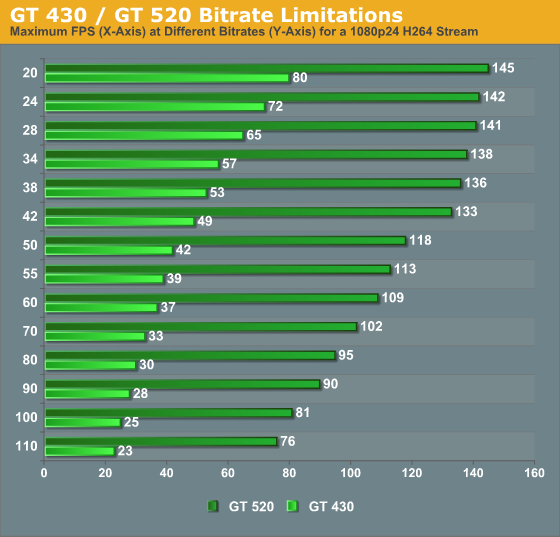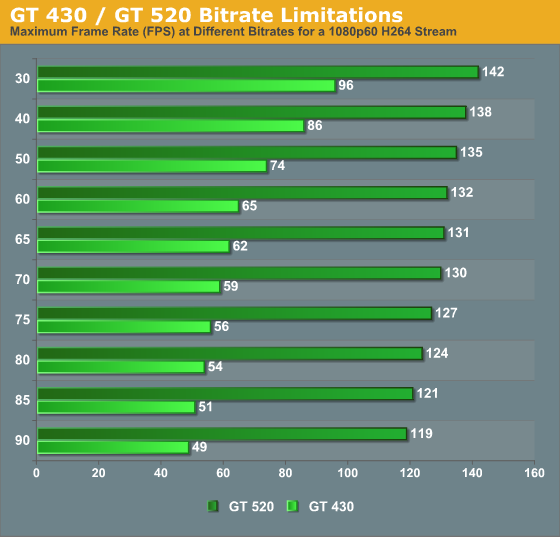Discrete HTPC GPU Shootout
by Ganesh T S on June 12, 2011 10:30 PM ESTIn the previous section, I mentioned about the bitrate limitations of the GT 430 when decoding 1080p H264 clips. NVIDIA confirmed that the GT 430 couldn't decode 60 fps videos at 80 Mbps. This piqued my curiosity and I tried out a few experiments to find out whether bitrate limitations exist for the usual 1080p24 videos on both the GT 430 and GT 520.
The DXVA Checker benchmark was repeated for all the bitrate testing files found in the NMT test files upto 110 Mbps.

We also created our own suite of bitrate testing streams at 1080p60. Running them through the DXVA Checker benchmark yielded the following results.

The results are presented in a bar chart above (A line chart would have made much more sense, but the outer values get placed only for bar charts in our graphing engine). For 1080p24 streams, we find that the GT 430 is unable to keep up with the real time decode frame rate requirements at 110 Mbps. For 1080p60 streams, the limit gets further reduced to somewhere between 65 and 70 Mbps. The GT 520 has no such issues.
The above testing is only of academic interest, since there is no real 1080p24 content at 110 Mbps. Even 3D Blu-rays max out around 60 Mbps (and that includes the audio stream!), so users shouldn't really be concerned about this bitrate limitation of the GT 430.
The GT 520's scores above are more interesting. Even the high end GPUs such as the 460 and 560 are unable to achieve that frame rate. The answer was buried in the README for the latest Linux drivers. The GT 520 is the first (and only GPU as of now) to support the VDPAU Feature Set D.
We asked NVIDIA about the changes in the new VDPAU feature set and what it meant for Windows users. They indicated that the new VPU was a faster version, also capable of decoding 4K x 2K videos. This means that the existing dual stream acceleration for 1080p videos has now been bumped up to quad stream acceleration.
Though the GPU can decode 4K videos, it is unfortunately not able to output it through HDMI. Despite the HDMI controller being advertised as HDMI 1.4a, it doesn't implement the 4K x 2K resolution part of the standard. The lack of HDMI sinks which accept that resolution is another matter, but that should get resolved in the next few years.
Despite the GT 520's advanced VPU engine, the lack of shaders limits its post processing capabilities. With all post processing options enabled, the GT 520's GPU load was always between 60 and 80%. The memory controller load (DRAM bandwidth usage) was between 20 and 40%. Despite the headroom apparently available, NVIDIA indicated that there weren't enough shaders available to implement the more advanced deinterlacing algorithms.










70 Comments
View All Comments
enki - Monday, June 13, 2011 - link
How about a short conclusion section for those who just use a Windows 7 box with a Ceton tuner card to watch hdtv in Windows Media Center? (i.e. will just be playing back WTV files recorded directly on the box)What provides the best quality output?
What can stream better then stereo over HDMI? On my old 3400 ATI card it either streams the Dolby Digital directly (the computer doesn't do any processing of the audio) or can output stereo (doesn't think there can be more then 2 speakers connected)
Thanks
BernardP - Monday, June 13, 2011 - link
The inability to create and scale custom resolutions within AMD graphics drivers is, for me, a deal-breaker that keeps me from even considering AMD graphics. It will also keep me from Llano, Trinity and future AMD Fusion APU's. I'll stay with NVidia as long as they keep allowing for custom resolutions.My older eyes are grateful for the custom 1536 X 960 desktop resolution on my 24 inch 16:10 monitor. I couldn't create this resolution with AMD graphics drivers.
bobbozzo - Tuesday, June 14, 2011 - link
In your case, you should just increase the size of the fonts and widgets instead of lowering the screen res.Assimilator87 - Tuesday, June 14, 2011 - link
I wish there was a section dedicated to the silent stream bug. I have a GTX 470 hooked up to an Onkyo TX-SR805 and this issue is driving me insane. For instance, does this issue only plague certain cards or do all nVidia suffer from it? I was hoping the latest WHQL driver (275.33) would fix this, but sadly, no. Otherwise, the article was amazing and I'll definitely have to check out LAV Splitter.ganeshts - Tuesday, June 14, 2011 - link
The problem with the silent stream bug is that one driver version has it, the next one doesn't and then the next release brings it back. It is hard to pinpoint where the issue is.Amongst our candidates, even with the same driver release, the GT 520 had the bug, but the GT 430 didn't. I am quite confident that the GT 520 issue will get resolved in a future update, but then, I can just hope that it doesn't break the GT 430.
JoeHH - Tuesday, June 14, 2011 - link
This is simply one of the best articles I have ever seen about HTPC. Congrats Ganesh and thank you. Very informative and useful.bobbozzo - Tuesday, June 14, 2011 - link
Hi, Can you please compare hardware de-intelacing, etc., vs software?e.g. many players/codecs can do de-interlacing, de-noise, etc. in software, using the CPU.
How does this compare with a hardware implementation?
thanks
ganeshts - Tuesday, June 14, 2011 - link
This is a good suggestion. Let me try that out in the next HTPC / GPU piece.CiNcH - Wednesday, June 15, 2011 - link
Hey guys,here is how I understand the refresh rate issue. It does not matter weather it is 0.005 Hz off. You can't calculate frame drops/repeats from that. In DirectShow, frames are scheduled with the graph reference clock. So the real problem is how much the clock which the VSync is based on and the reference clock in the DirectShow graph drift from each other. And here comes ReClock into play. It derives the DirectShow graph clock from the VSync, i.e. synchronizes the two. So it does not matter weather your VSync is off as long as playback speed is adjusted accordingly. A problem here is synchronizing audio which is not too easy if you bitstream it...
NikosD - Thursday, June 16, 2011 - link
Nice guide but you missed something.It's called PotPlayer, it's free and has built-in almost everything.
CPU & DXVA (partial, full) codecs and splitters for almost every container and every video file out there.
The same is true for audio, too.
It has even Pass through (S/PDIF, HDMI) for AC3/TrueHD/DTS, DTS-HD. Only EAC3 is not working.
It has also support for madVR and a unique DXVA-renderless mode which combines DXVA & madVR!
I think it's close to perfect!
BTW, in the article says that there is no free audio decoder for DTS, DTS-HD.
That's not correct.
FFDShow is capable of decoding and pass through (S/PDIF, HDMI) both DTS and DTS-HD.
And PotPlayer of course!